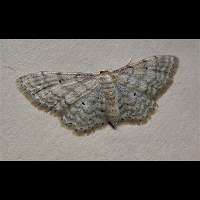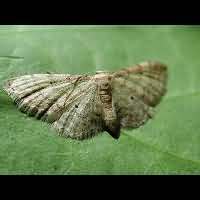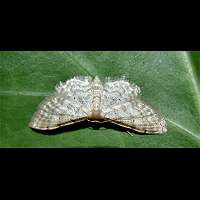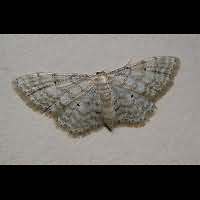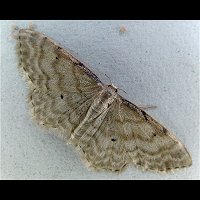Dwarf Cream Wave (Idaea fuscovenosa)
The Dwarf Cream Wave is a very small Geometer Moth, showing a creamy white basic colour. Contrary to many other waves it slightly glistens. On all wings it shows a clear, small black dot (the so-called discal spot). Near the edge of the wing run three parallel, very wavy lines, usually brownish, but sometimes greyish in colour. There is an interrupted blackish brown thin line just in front of the fringes. The leading edge of the front wings is brownish, usually much more so than in the animal depicted here. The wingspan is 18 to 23 mm only.
The caterpillar of the Dwarf Cream Wave is brownish. It is visibly tapered towards the head. Near the tail there often is one lighter segment, usually yellowish brown. On the back it shows vague markings of dark brown or black intertwined V's or W's. The first larvae appear in August. The larvae overwinter. Not much is known about the host plants, but probably the caterpillar is polyphagous, to be found on among others brambles and dandelions.
The Dwarf Cream Wave flies in one generation a year. It is on the wing in June and July. During daytime it is resting in shrubs and trees, but is easily disturbed. Flies from early dusk to after midnight, but is attracted to light only sparingly. A common, but local species. It prefers light soils and open spaces covered with bushes and trees. Very common in coastal areas up to Wales. Otherwise common in Southern parts of Engeland, getting scarcer northwards. The Mersey seems to be the northern border of its range in Britain. On the continent a local species as well and especially common in many coastal areas.
The Dwarf Cream Wave is a very small Geometer Moth, showing a creamy white basic colour. Contrary to many other waves it slightly glistens. On all wings it shows a clear, small black dot (the so-called discal spot). Near the edge of the wing run three parallel, very wavy lines, usually brownish, but sometimes greyish in colour. There is an interrupted blackish brown thin line just in front of the fringes. The leading edge of the front wings is brownish, usually much more so than in the animal depicted here. The wingspan is 18 to 23 mm only.
The caterpillar of the Dwarf Cream Wave is brownish. It is visibly tapered towards the head. Near the tail there often is one lighter segment, usually yellowish brown. On the back it shows vague markings of dark brown or black intertwined V's or W's. The first larvae appear in August. The larvae overwinter. Not much is known about the host plants, but probably the caterpillar is polyphagous, to be found on among others brambles and dandelions.
The Dwarf Cream Wave flies in one generation a year. It is on the wing in June and July. During daytime it is resting in shrubs and trees, but is easily disturbed. Flies from early dusk to after midnight, but is attracted to light only sparingly. A common, but local species. It prefers light soils and open spaces covered with bushes and trees. Very common in coastal areas up to Wales. Otherwise common in Southern parts of Engeland, getting scarcer northwards. The Mersey seems to be the northern border of its range in Britain. On the continent a local species as well and especially common in many coastal areas.

